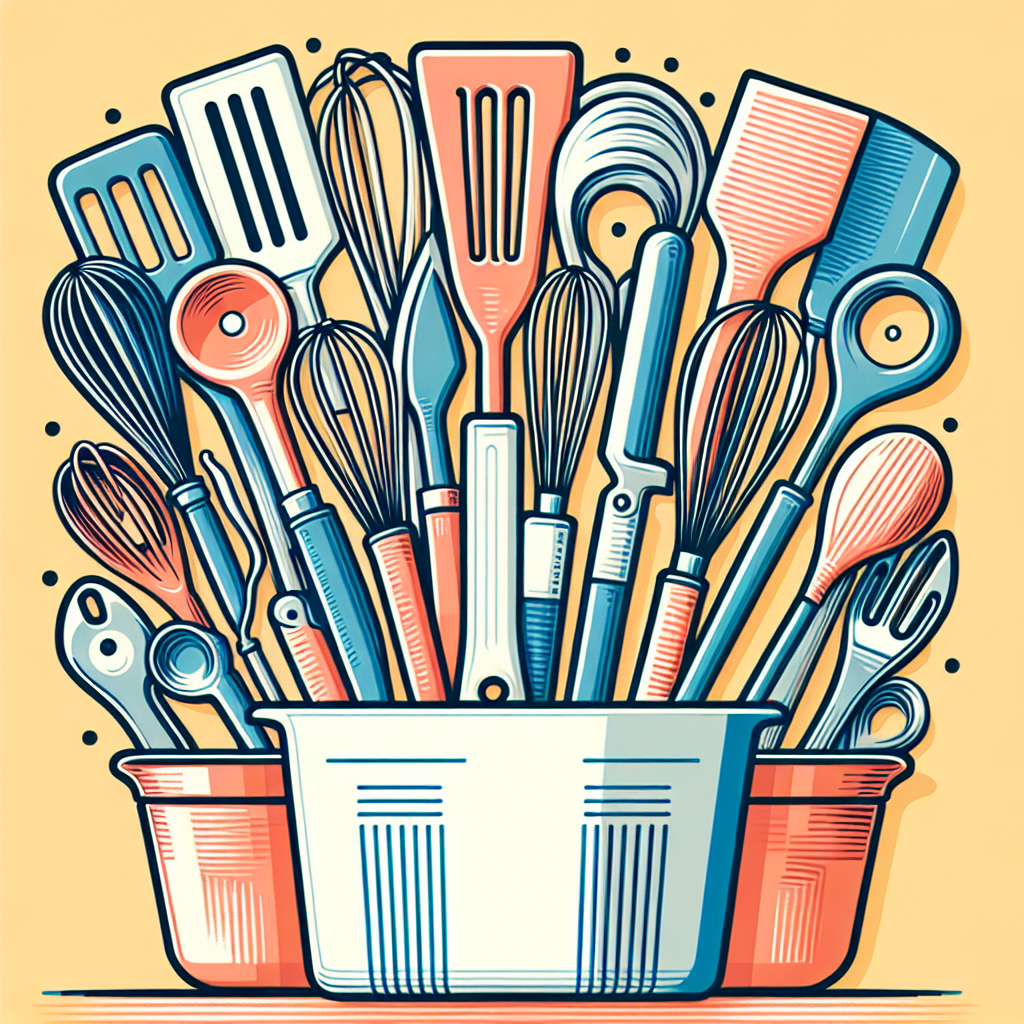In this article, discover valuable tips for maximizing the efficiency of your kitchen tool organization. Tired of rummaging through cluttered drawers and cabinets to find the right utensil or gadget? We’ve got you covered! Explore the latest kitchen gadgets and essential tools to make your cooking experience seamless and enjoyable. Tastepan.com reviews and recommends top-quality kitchen equipment, from cookware and utensils to appliances, helping you choose the best for your culinary needs. With our helpful tips, you’ll be able to streamline your kitchen, saving you time and energy in the process. So get ready to whip up delicious meals with ease as we dive into the world of kitchen tool organization.

Categorize Your Tools
Group by function
When organizing your kitchen tools, it’s important to categorize them by function. This means grouping similar tools together based on their purpose. For example, you could create categories such as baking tools, cooking utensils, cutting tools, and measuring instruments. By grouping your tools this way, you’ll be able to quickly locate what you need when you’re in the middle of a recipe.
Separate by frequency of use
Another helpful tip is to separate your tools based on their frequency of use. Keep the tools you use most frequently within easy reach, such as in a utensil holder on your countertop or in a drawer near your cooking area. Less frequently used tools can be stored further away or in less accessible areas. This will make your kitchen more efficient and save you time when you’re cooking or baking.
Sort by size
Sorting your tools by size is also a great way to enhance your kitchen organization. You can assign different drawers or sections of your cabinets to hold tools of similar size. This will not only make it easier to find what you’re looking for, but it will also help maximize the use of your storage space. Small tools like measuring spoons and peelers can be stored in a designated drawer, while larger items like mixing bowls and pots can be placed on your shelves or in deeper cabinets.
Arrange for convenience
Lastly, arrange your tools in a way that is convenient for your cooking style. Think about how you move around your kitchen when you’re preparing a meal and place your most commonly used tools in easily accessible locations. This could mean keeping your cutting board, knives, and mixing bowls close to your prep area, while storing less frequently used tools like specialty gadgets or seasonal items in a less convenient spot.
Utilize Drawer Space
Invest in drawer dividers
If you want to make the most of your drawer space, consider investing in drawer dividers. These handy organizers will allow you to create specific compartments for different types of tools, making it easier to find and retrieve what you need. You can find adjustable dividers that can be customized to fit your drawer size and accommodate various tool sizes.
Arrange tools by size and type
When organizing your tools in drawers, arrange them by size and type. Begin by placing larger tools at the back of the drawer and smaller ones towards the front. This will ensure that you have a clear view of all your tools and minimize the chances of items getting buried and forgotten. Additionally, grouping similar-sized tools together will also make it easier to locate what you need quickly.
Keep frequently used tools within reach
As mentioned before, it’s important to keep your frequently used tools within easy reach. Place them in the top drawers or in a utensil holder on your countertop. This will save you time and effort when you’re in the middle of cooking and require immediate access to your go-to tools like spatulas, tongs, or whisks.
Consider vertical storage options
If you have limited drawer space, consider incorporating vertical storage options. You can use drawer organizers that stack on top of each other, creating multiple layers of storage within a single drawer. This works especially well for smaller tools or gadgets that don’t take up much space but can be easily lost if not organized properly.

Maximize Cabinet Storage
Install adjustable shelves
To maximize your cabinet storage space, consider installing adjustable shelves. These shelves can be moved up or down, allowing you to customize the height according to the size of your tools. Adjustable shelves are especially useful for accommodating taller items like blender pitchers or mixing bowls.
Use hooks or racks
Utilize hooks or racks within your cabinets to hang tools that don’t fit well on shelves. This can be particularly helpful for storing pots, pans, and lids. By hanging them, you’ll free up space on your shelves for other items and keep your pots and pans easily accessible.
Store lids separately
One common problem when organizing cabinets is dealing with pot and pan lids. To keep them from cluttering your cabinets, consider storing them separately. You can use a lid organizer that attaches to the inside of your cabinet door, allowing you to neatly stack and store your lids without taking up valuable space.
Utilize the back of cabinet doors
The back of your cabinet doors can also provide valuable storage space. Install hooks or racks on the inside of the doors to hang tools like measuring cups, spoons, or oven mitts. This way, these frequently used items will be within reach but won’t take up any additional space in your cabinets.
Optimize Countertop Organization
Keep frequently used tools within reach
Similar to organizing your drawers, it’s important to keep your frequently used tools on your countertop, within easy reach. This could include items like your cutting board, chef’s knife, wooden spoons, or spatulas. By doing so, you’ll save time and effort when you need to grab them quickly during meal preparation.
Use canisters or containers for smaller items
For smaller items like measuring spoons, whisks, or small gadgets, consider using canisters or containers. These will keep these items organized and prevent them from getting lost among larger tools. Choose clear containers so you can easily identify the contents or opt for decorative ones that match your kitchen decor.
Utilize a utensil holder or crock
A utensil holder or crock is a great way to store your larger utensils like wooden spoons, serving forks, or tongs. These holders can sit directly on your countertop, keeping your utensils organized and easily accessible. Look for one with dividers or multiple compartments to keep your utensils separated and prevent them from getting tangled.
Keep only essential tools on the countertop
To maintain a clutter-free countertop, keep only your essential tools within easy reach. This will vary depending on your cooking style and preferences, but it’s generally recommended to limit your countertop to a few key items. This will not only keep your workspace clear but also make cleaning and food preparation more efficient.

Consider Wall Storage
Install a pegboard
A pegboard is a versatile and customizable storage solution for your kitchen. Installing a pegboard on a unused wall allows you to hang your tools using hooks or pegs, keeping them off your countertops and freeing up valuable space. You can arrange the tools in a way that is visually appealing, making them both functional and decorative.
Use magnetic strips or hooks
Magnetic strips or hooks are another great option for wall storage. You can attach these to your backsplash or any other vertical surface and hang your metal tools like knives, scissors, or can openers. This method keeps your tools easily accessible while adding a sleek and modern touch to your kitchen.
Hang wall-mounted shelves
Wall-mounted shelves provide additional storage space for your tools while adding visual interest to your kitchen walls. These shelves can hold larger items like pots, pans, or specialty appliances that you don’t use regularly. By displaying them on the wall, you’ll free up cabinet space and create a unique decorative element in your kitchen.
Display decorative and frequently used tools
When utilizing wall storage, consider displaying both decorative and frequently used tools. This will add style and personality to your kitchen while also making your most-used tools easily accessible. Hang items like colorful spatulas, ladles, or whisks, creating a functional and visually appealing display.
Label and Sort
Label containers or drawers
To maintain an organized system, it’s important to label your containers or drawers. This will help you and others quickly identify the contents of each container, saving time and reducing the chances of misplacing items. Use adhesive labels or a label maker to clearly indicate what should be stored in each designated space.
Create a system for sorting tools
Creating a system for sorting your tools will make it easier to find what you’re looking for. Whether it’s sorting by function, size, or frequency of use, establish a consistent method that works for you. For example, you could assign different colored containers or drawers for each category, making it visually clear where each type of tool should be stored.
Color-code utensils for easy identification
One way to make your tools even more organized is by color-coding them. Assign a specific color to each type of utensil, such as red for baking tools, green for cutting tools, or blue for measuring instruments. This will enable you to quickly identify the tool you need and keep everything in its designated place.
Maintain a consistent organization system
Once you’ve established an organization system, it’s crucial to maintain it consistently. Put items back in their designated spaces after each use and resist the temptation to let clutter accumulate. By staying committed to your organizational system, you’ll save time and prevent frustration in the long run.
Declutter Regularly
Get rid of duplicate or unused tools
Regularly take inventory of your kitchen tools and get rid of any duplicates or unused items. If you have multiple tools that serve the same purpose, keep the one you prefer and donate or sell the rest. Similarly, if there are tools you haven’t used in a long time or don’t see yourself using in the future, consider donating them to someone in need or selling them online.
Donate or sell tools you no longer need
Kitchen tools can be expensive, so if you have items that are still in good condition but are no longer useful to you, consider donating them to a local charity or selling them second-hand. This will not only help you declutter your kitchen but also allow others to benefit from tools they may not be able to afford.
Reassess your organization system periodically
Every so often, take the time to reassess your organization system. As your cooking needs and equipment change, you may find that certain tools need to be rearranged or that you require additional storage solutions. By periodically reviewing and adjusting your system, you’ll ensure that it continues to meet your needs and maximize your kitchen’s efficiency.
Keep countertops and drawers clutter-free
To maintain a clean and organized kitchen, make it a habit to regularly clear your countertops and drawers of any unnecessary clutter. Put away tools you’re not using, wipe down surfaces, and create a visually pleasing and functional workspace. This will not only enhance the efficiency of your cooking but also create a welcoming environment in your kitchen.
Maintain Cleanliness
Clean tools before storing
Before storing your kitchen tools, make sure to clean them thoroughly. Wash utensils with soap and water, paying attention to any food residue or grease. For items like cutting boards or bowls, use appropriate cleaning methods to ensure they are sanitized and ready for your next use. Storing clean tools will prevent the spread of bacteria and keep your storage areas hygienic.
Regularly wipe down storage areas
In addition to cleaning your tools, it’s important to regularly wipe down your storage areas. Dust and crumbs can accumulate over time, so take a few minutes to clean out your drawers, shelves, and countertops. Use a microfiber cloth or a mild cleaning solution to remove any dirt, grime, or spills. This simple step will keep your storage areas looking fresh and prevent any potential cross-contamination.
Avoid storing dirty or wet tools
To maintain the cleanliness of your kitchen tools and storage areas, avoid storing dirty or wet tools. Moisture can lead to the growth of bacteria, while food residue can attract pests. Always make sure your tools are completely dry before storing them. If possible, store utensils and gadgets in airtight containers or sealed bags to further protect them from environmental factors.
Implement a cleaning and maintenance routine
To keep your kitchen tools and storage areas in optimal condition, implement a regular cleaning and maintenance routine. Set aside time each week to clean and organize your tools, as well as wipe down your storage spaces. This proactive approach will help you stay on top of clutter and ensure that your kitchen remains a clean and enjoyable space to work in.
Consider Ergonomics
Arrange frequently used tools at comfortable heights
When organizing your kitchen tools, consider ergonomics and arrange frequently used items at comfortable heights. Place items like cutting boards, knives, and mixing bowls at a height that is comfortable for your height and preferred working posture. This will help reduce strain on your body and make your cooking experience more enjoyable.
Store heavier tools in easily accessible locations
Heavier or bulkier tools like pots, pans, and large appliances should be stored in easily accessible locations. This means placing them at waist level or within arm’s reach, so you don’t have to strain or lift heavy objects from low or high cabinets. Prioritize your safety and convenience when determining the placement of these heavier items.
Use kitchen tool organizers to reduce strain
Invest in kitchen tool organizers that are designed to reduce strain on your body. For example, there are knife blocks or magnetic strips that can hold your knives in a way that allows for easy access without bending or reaching. Similarly, there are pot and pan organizers that can pull out or rotate, eliminating the need to lift heavy cookware.
Consider the placement of handles and grips
When organizing your tools, pay attention to the placement of handles and grips. Try to position items with handles facing outward, making them easy to grab and minimizing the risk of dropping or fumbling with them. Additionally, consider investing in tools with ergonomic handles or grips, as they are designed to be more comfortable and reduce strain on your hands and wrists.
Customize for Your Needs
Assess your kitchen layout and storage options
Every kitchen is different, so it’s important to assess your kitchen layout and storage options before implementing an organization system. Take into consideration the size and layout of your cabinets, drawers, and countertop space. This will help you determine the best locations for storing your tools and which storage solutions will work best for your specific kitchen.
Consider specific needs for different types of tools
Not all kitchen tools are created equal, so it’s important to consider their specific needs when organizing. For example, delicate glassware or fragile baking dishes may require extra padding or careful stacking to avoid damage. On the other hand, sharp knives should be stored in a way that protects both the blades and your fingers. Customizing your storage solutions based on the unique requirements of each tool will help prolong their lifespan and ensure they remain in good condition.
Adapt organization methods to fit your cooking style
Your cooking style and preferences should also play a role in how you organize your kitchen tools. If you frequently bake, you may need more space for baking sheets, cake pans, and cooling racks. If you’re an avid home cook, you may require extra storage for a wide range of utensils and gadgets. Tailor your organization methods to fit your specific cooking habits and ensure that your tools are easily accessible and within reach when you need them.
Personalize your organization system
Ultimately, your organization system should reflect your personal style and preferences. Feel free to personalize your system by adding decorative touches or incorporating elements that match your kitchen decor. By making your organization system visually appealing and aligned with your taste, you’ll be more motivated to maintain its upkeep and enjoy the process of cooking in a well-organized kitchen.
In conclusion, organizing your kitchen tools is essential for efficiency and enjoyment during your cooking experiences. By categorizing your tools based on their function, separating them by frequency of use, sorting them by size, and arranging them for convenience, you can create a well-organized kitchen space. Utilize drawer space with dividers, maximize cabinet storage with adjustable shelves and hooks, optimize countertop organization with canisters or containers, consider wall storage options like pegboards or magnetic strips, and label and sort your tools for easy identification. Declutter regularly, maintain cleanliness by cleaning your tools before storing and wiping down storage areas, consider ergonomics when arranging your tools, and customize your organization system to fit your needs and cooking style. With these tips, your kitchen tools will be organized and ready for whenever culinary inspiration strikes. Happy cooking!

